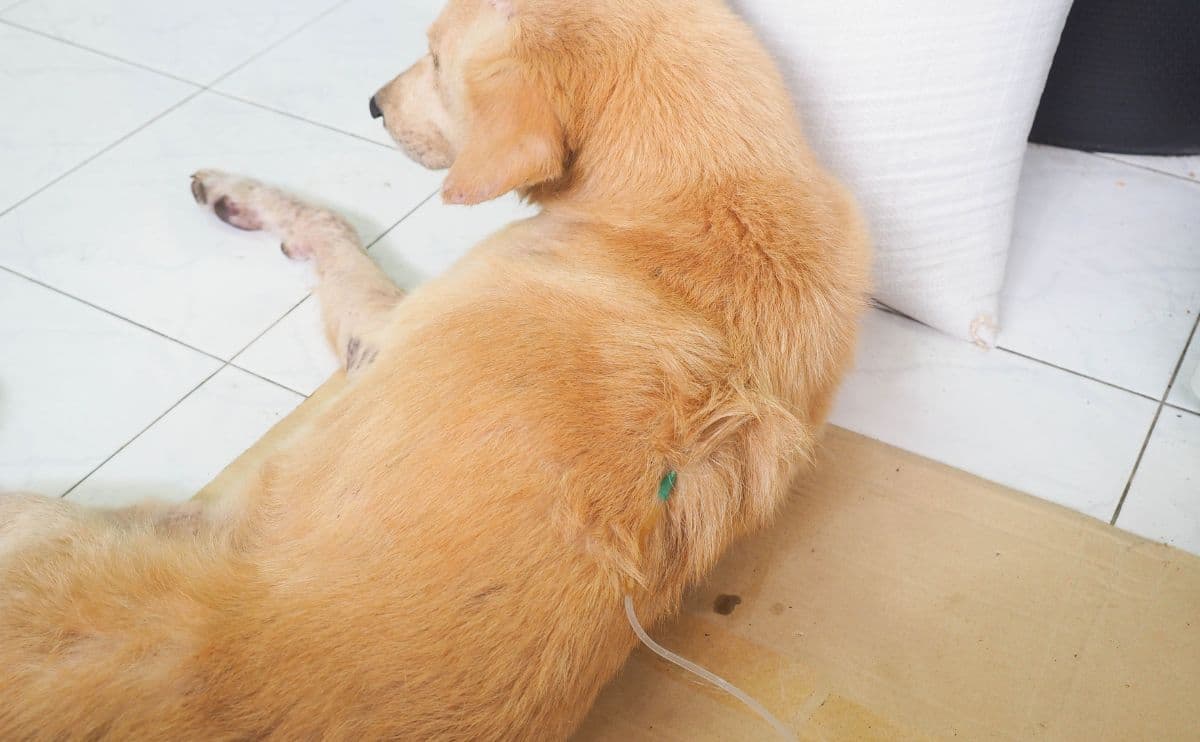This content was reviewed by veterinarian Dr. JoAnna Pendergrass, DVM.
When you purchase through links on our site, we may earn a commission. Here’s how it works.

In humans, malignant melanoma is the deadliest form of skin cancer, but can dogs get melanoma?
The unfortunate answer is yes — however, just like with humans, there are varying types of melanoma that affect different parts of a dog’s body. Some types are more serious than others. But with any type of cancer, an early diagnosis is key to catching this potential killer before it’s too late.
What Causes Melanoma In Dogs?
While ultraviolet light is a major cause of human melanomas, this doesn’t appear to be as much of a factor with the canine form of this cancer. However, no one knows the exact cause of melanoma in dogs. Researchers believe that it could be due to a combination of genetics and environmental factors.
Types Of Melanoma In Dogs

The different types and locations of melanoma in dogs include:
- Cutaneous Melanoma: appears on the skin
- Ocular Melanoma: found on a dog’s eyelids or directly on the eye
- Oral Melanoma: appears anywhere around the mouth or oral cavity (accounts for 80% of all melanomas in dogs)
- Subungual Melanoma: found in between the toes and the toenail bed
Melanomas are categorized as either benign or malignant. Benign melanomas are typically harmless with a very low risk of spreading, or metastasizing, to other parts of the body.
Malignant melanomas, however, can metastasize very quickly, spreading to other parts of a dog’s body, particularly the lungs, liver, and lymph nodes. For this reason, malignant melanomas in dogs present a dire health risk.
How To Identify Melanomas: Signs & Symptoms
One of the scariest aspects of malignant melanomas is that dogs usually show subtle to no symptoms of being sick until the cancer has spread to other areas of their body.
Although most skin and eye melanomas in dogs are benign, it’s always a good idea to play it safe. If you notice an unusual lump or discolored area on any part of your pup, contact your veterinarian.
Tip: You should also be concerned if any changes occur in the appearance of any growth or lump. Such changes include the size, shape, color, and ulceration. Vets often recommend familiarizing yourself with all your dog’s natural lumps, bumps, and rashes when your dog is young and healthy, so you’ll know when changes occur.
Cutaneous (Skin) Melanomas
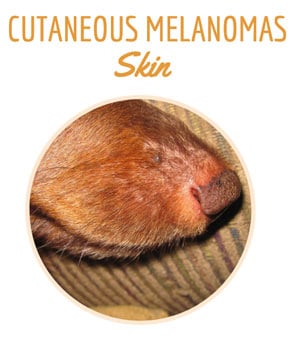
Unlike in humans, most cutaneous melanomas are benign in dogs. But it can be difficult to distinguish between benign and malignant melanomas on your dog’s skin unless you’re an expert.
Skin melanomas most often have the physical characteristics that are listed below:
- Round, firm, slightly raised, and darkly pigmented masses on your dog’s skin
- Masses are usually from 1/4″ to 2″ in diameter
- They occur most often on the head, back, or toes
- Coloration can vary from black, brown, gray, or red
Ocular (Eye) Melanomas
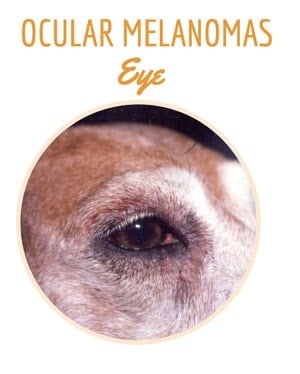
Melanomas in or around a dog’s eyes are almost always benign and rarely metastasize. But they can impair your dog’s vision and cause discomfort.
If your dog has ocular melanoma, you may notice:
- A dark-colored mass in the eye or eyelid
- Darkening of the iris
- Eye redness
- Cloudy eyes
- Swelling in or around your dog’s eye
- Twitching muscles around the eyes
Oral (Mouth) Melanoma
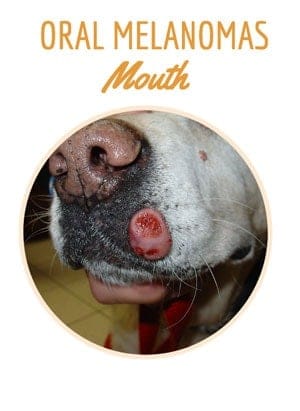
Oral melanomas are the most common type of canine melanoma, accounting for 80% to 85% of all melanomas in dogs. Malignant melanomas in a dog’s mouth can infiltrate deep into the bone, and they metastasize in up to 80% of dogs.
Malignant oral melanomas have the physical characteristics that are listed below:
- Raised lumps around the mouth
- Often ulcerated
- Appear as gray or pink
Symptoms can include:
- Noticeable facial swelling
- Raised masses in the mouth
- Excessive salivation
- Bad breath
- Weight loss
- Inability to eat; dropping food from the mouth
- Loose teeth
Subungual (Nail Bed) Melanoma
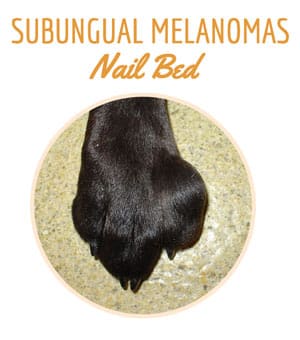
Melanomas in your dog’s nail bed are the second most common location and account for roughly 15% to 20% of all canine melanomas. Metastatic rates are high at 80%, similar to the oral form of the cancer.
Subungual, or nail bed, malignant melanomas typically first appear as toe swelling and can even cause the loss of the toenail. These types of nail and foot-related tumors often develop a secondary infection, which can lead to a misdiagnosis.
Melanomas in nail beds or toes often lead to:
- Limping
- Swelling, bleeding, or discharge from the affected toe
- Licking or chewing at the affected area
Signs That Melanoma Has Spread
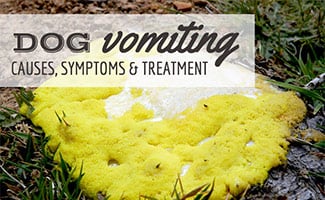
In the case of oral melanomas, if a tumor has spread to local lymph nodes, you may notice swelling under either side of the lower jaw (submandibular lymph nodes) or in front of the shoulders (prescapular lymph nodes).
The symptoms that canine oral melanoma has spread to the lungs or liver may include:
- Lethargy
- Weakness
- Decreased appetite
- Vomiting
- Coughing
- Swelling of the abdomen with fluid
Diagnosis
If you suspect there may be an issue, promptly schedule a vet appointment.
Some melanomas can be diagnosed with fine needle aspiration, a procedure in which your vet inserts a needle into the tumor or lesion and draws out some cells. This may require sedation.
Sometimes a biopsy is required. Your vet will remove a small piece of tissue and send it to the laboratory for a pathologist to determine a definitive diagnosis. Biopsies require anesthesia. Biopsy results can also tell your vet if the melanoma may spread to other organs.
Other potential diagnostic tests include:
- Chest x-rays to see if the melanoma has metastasized to the lungs
- Abdominal ultrasound tests to determine if any other organs have been affected
Treatments

Treatments for canine melanoma depend on the tumor’s location and how much the cancer has spread.
Surgery
Surgical removal is usually the first step for both benign and malignant melanomas. Often, benign lesions are removed to reduce discomfort and avoid the chance of them becoming malignant. A pathologist will examine the removed mass under a microscope to determine if the mass is benign or malignant.
Malignant melanomas require surgical removal of the mass, surrounding tissue, and affected bone. In the case of oral melanomas, part of the dog’s jaw may need to be removed. Subungual melanoma may require amputation of the toe. Fortunately, reconstructive surgery can help to rebuild these areas.
Radiation & Chemotherapy
If the melanoma metastasized or couldn’t entirely be removed, your vet will likely use radiation therapy. Your vet could also opt for chemotherapy in conjunction with surgery and radiation therapy. Chemotherapy as a replacement for surgery and radiation has not proven to be a successful treatment for malignant melanomas.
Vaccinations
The USDA conditionally approved the Merial melanoma vaccine for dogs in 2007, but the research is still ongoing about its efficacy. The hope for this vaccine is that it causes the immune system to attack cancerous cells and prolong overall survival times.
Your Existing Pet Insurance Policy May Cover Cancer Treatment
All of the national pet insurance companies offer some cancer coverage so be sure to check with them before your vet determines that your dog has melanoma; doing so could save some money on treatment. However, if you do not already have an active policy with a carrier, a cancer diagnosis is not the best time to sign up because pre-existing conditions are not covered.
Prognosis & Survival Rates

How long can dogs live with melanoma? It depends on many factors. Dogs with surgically removed benign tumors have an overall excellent prognosis.
The life expectancy for dogs with malignant melanomas depends on the location and when the cancer was diagnosed and treated. Like with human cancers, veterinarians determine prognosis and survival according to the stage of the cancer’s progression, e.g., Stage 1-4 cancer.
For survival rates, we’re focusing on oral melanomas because they account for 80%-85% of all canine melanomas. In general, the smaller the tumor and the closer it is to the front of the mouth, the better the prognosis.
Survival Statistics For Oral Melanoma:1
- Dogs with untreated oral melanoma have an average survival time of 65 days
- For dogs treated with surgery alone, average survival times range from 5-17 months and 1-year survival rates range from 21%-27%
- For dogs treated with radiation therapy, the response rate ranges from 83%-100% and survival times range from 211-363 days
- Response rates with traditional chemotherapy are low (30%)
- Preliminary results from Merial vaccine studies report that dogs with advanced oral melanoma that receive the vaccine survive for an average of 224-389 days. This survival time improves to nearly 600 days if the dog undergoes surgery or radiation therapy to control the primary tumor.
Which Breeds Are At A Higher Risk?

Most common in dogs nine years and older, melanoma can affect any dog breed, although, generally, small breeds are more at risk. Malignant melanomas are also more likely to appear in the toes or toenail beds of black dogs.
- Airedales
- Boston Terriers
- Cocker Spaniels
- Doberman Pinschers
- Golden Retrievers
- Gordon Setters
- Irish Setters
- Miniature & Giant Schnauzers
- Springer Spaniels
- Scottish Terriers
The Emotional Toll Of Canine Cancer: One Owner’s Experience
- Ongoing Claims: $11,263
- Healthy Paws Pet Insurance Reimbursement: $9,696
- (90% reimbursement rate/$500 deductible)

When pet parent Jamie noticed a blood blister on the top of her dog’s tooth, she was a little worried. Guinness, the family’s 6-1/2-year-old Bernese Mountain Dog, had a few other bumps on his gums, so she contacted her vet.
“The flesh colored lumps were not that worrisome BUT a separate, raised, black bump on his upper lip was a more major concern and should be removed,” says Jamie. The bump was a sign of melanoma (a diagnosis would come later). At the time, the vet didn’t mention melanoma, so they booked the next available surgery: three weeks out.
“Now, knowing what that black bump was, I wish we had demanded an earlier surgery. Also, with hindsight and a full reflection of the signs and symptoms of melanoma, we could see that an increase in bad breath, extra saliva, and smacking of his lips were additional indicators of what was to come,” Jamie says.
Guinness’s Treatment
Guinness’s surgery was a success. A few days later, though, Jamie received a call with a diagnosis: it was oral melanoma. The vet advised her to “wait and see.” However, Jamie was instantly on the phone with a veterinary oncologist, scheduling an appointment for the very next morning.
“We have Healthy Paws Pet Insurance so I didn’t need to take a ‘wait-and-see’ approach but rather go full guns blazing to make sure my fur baby received the care that he deserved.”
At the appointment the next day, Guinness had some ultrasounds and x-rays, and Jamie received good news: the cancer had not yet spread, and his cancer was diagnosed as Stage 1. They scheduled his second surgery to gain wider clean margins (where no cancer cells are seen at the outer edge of the tissue that was removed), and Guinness was not recommended for radiation.
Rather, Guinness began immunotherapy in the form of the oral melanoma vaccine. “This is a procedure that occurs every two weeks for the first four series and then again twice a year for the rest of his life,” explains Jamie.
So far, since his diagnosis in November 2018, Guinness’s vet bills have totaled $11,263, and Jamie has been reimbursed $9,696 (90% reimbursement rate and $500 deductible).
“At each and every step and decision, I was advised of the best case option but then asked to review medical invoicing estimates before any of those steps could be scheduled,” says Jamie. Luckily, she never once had to look at the bottom line when determining what the best course of action was for Guinness and her family because she had pet insurance.
Guinness’s Recovery
Today Guinness is still as playful as ever and “always wants to be right up in the silly, chasing and dancing action. But when everyone sits still, he will be the first to come climb into your lap or lean onto your foot,” says Jamie. “He is an invaluable and integral part of our family, and we are so immensely happy and hopeful that he will remain that way because of prompt and aggressive treatment for his melanoma.”
The Costs Of Canine Cancer
A cancer diagnosis and treatment is one of the most costly situations you’ll have to face as a pet parent, both in terms of the emotional toll and financial obligations. The full treatment plan (surgery, chemo, and radiation) ranges between $6,000-10,000, on average.
If you fear your dog may develop cancer (or another serious illness) one day and you don’t want to have to decide between your wallet and treating your furry friend, investing in pet insurance is a wise option.
As long as you have pet insurance in place before your dog becomes sick, many of the best pet insurance providers will cover a portion of the thousands to tens of thousands of dollars for expensive surgery, radiation, and other treatments. This way you can focus on getting your pup healthy without worrying about how you’re going to pay for his care.
Sources: [1] Blue Pearl Vet
Tagged With: Reviewed By Dr. Pendergrass, DVM, Skin

